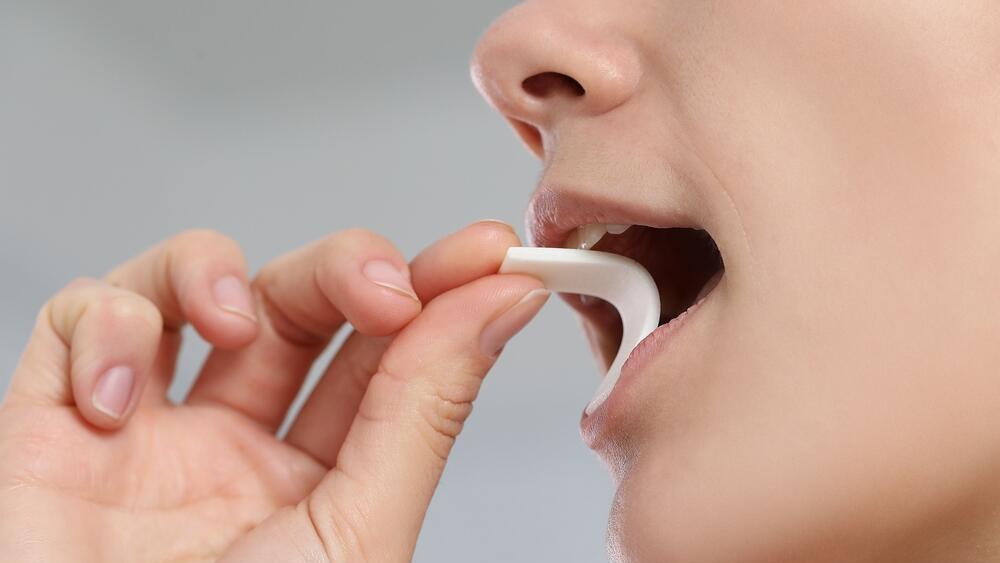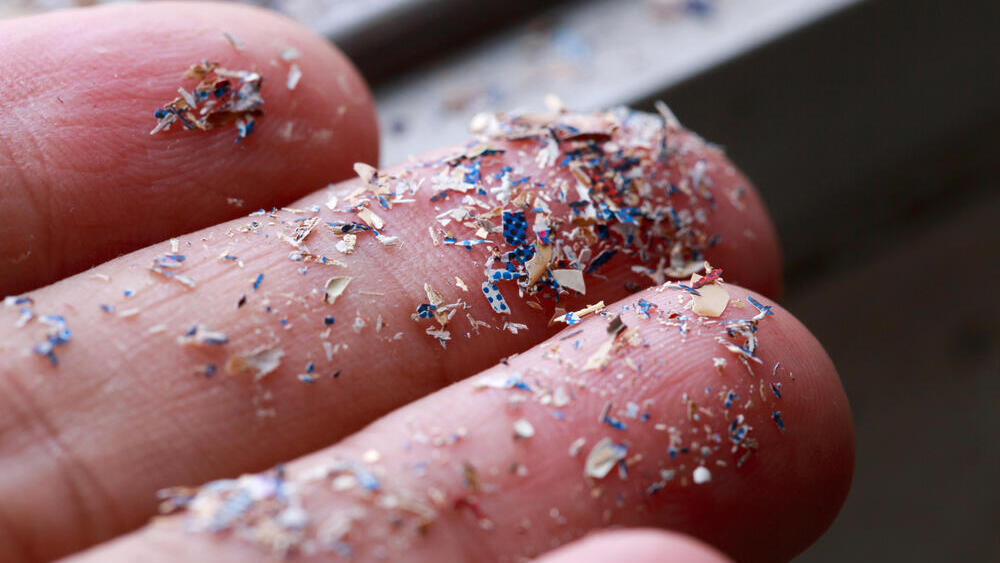Getting your Trinity Audio player ready...
Chewing gum might seem like a harmless daily habit, but a new study suggests it could be another source of exposure to microplastics—tiny plastic particles increasingly found in our environment and bodies.
The research, recently published by scientists at the University of California, Los Angeles (UCLA) and presented at the spring meeting of the American Chemical Society (ACS), found that commercial gums—both synthetic and natural—release significant amounts of microplastics into saliva during chewing. These findings add to a growing body of research showing microplastic contamination in water, air, soil and even within the human body.
“This research presents some rather troubling findings,” said Dr. Nirit Lev, head of the neurology department at Meir Medical Center and chair of the Israel Headache Society. “It highlights how surrounded we are by microplastics, even in the most unexpected places—including foods we consider safe. For example, even bottled mineral water has been shown to contain microplastic particles. While toxicological tests are conducted on many products to ensure they don’t contain harmful substances, microplastics aren't currently included in regulatory approval processes.”
One person, 70 gums
The study was based on an experiment involving ten different types of chewing gum—five synthetic and five natural—all sold in U.S. markets. Brand names were not disclosed. To reduce variability due to differences in chewing style and saliva composition, the researchers had a single participant chew all the samples—seven pieces from each brand.
That participant, Lisa Low, a PhD student at UCLA, rinsed her mouth several times with deionized water to establish a microplastic baseline. “She then chewed each gum for four minutes, and in some cases longer,” explained Dr. Lev. Saliva samples were collected throughout the chewing period and subjected to meticulous lab processing, including shaking, centrifugation, filtering and chemical digestion. Finally, the samples were examined under a microscope to detect plastic particles.
The results were clear: One gram of gum released between 100 and 600 microplastic particles on average. Given that a single piece of gum weighs between 1.5 to 6 grams, each piece could release hundreds, possibly even thousands, of particles into the mouth. Synthetic gums released about 104 particles per piece on average, while natural gums released around 96—an insignificant difference, indicating that the “natural” label does not guarantee plastic-free chewing.
Altogether, Low chewed 70 pieces of gum during the study. “It was surprising to find that natural gums released nearly the same amount of microplastics as synthetic ones,” she said.
Most microplastics are released in the first few minutes
The study found that 94% of microplastic particles are released within the first eight minutes of chewing. After that, the release rate gradually declines until it reaches a saturation point, where almost no more particles are emitted. “This means people who chew gum for long periods aren’t necessarily exposed to more microplastics,” noted Dr. Lev. “However, frequently switching between pieces—as many people do—could increase overall exposure.”
Assuming a person chews 160 to 180 pieces of gum per year—a relatively moderate level of consumption—that equates to potential exposure to around 30,000 microplastic particles annually from gum alone.
Where does the plastic come from?
Synthetic gums were found to contain significant amounts of polymers such as PET and polystyrene—materials commonly used in food packaging and plastic bottles—along with other petrochemical substances like synthetic rubber and polyvinyl acetate. Surprisingly, the “natural” gums, often made from tree resins or other plant-based materials, also contained plastic-like polymers, including polyolefins—commonly found in plastic bags and packaging. These polymers accounted for up to 50% of the plastic particles detected in the saliva samples.
The researchers pointed out that gum packaging doesn’t typically disclose polymer content. Often, the ingredient list simply includes vague terms like “gum base,” leaving the true composition unknown.
Dr. Sanjay Mohanty, professor of civil and environmental engineering and lead author of the study, emphasized a key difference between gum and other sources of microplastic exposure. “In products like bottled water or tea bags, plastic contamination comes from the packaging or production process. But with gum, the plastic is part of the food itself,” he told Health. While the health effects of ingesting microplastics are still under investigation, Mohanty said there's enough evidence to raise a red flag.
“The beginning of a new era”
“Over the past decade, microplastic particles have been found accumulating in nearly every organ in the body: lungs, bloodstream, brain, placenta, intestines and more,” said Dr. Lev. “Various studies have linked these particles to inflammatory responses, oxidative stress, DNA damage, metabolic disorders, cardiovascular risk, reduced fertility and neurological effects.”
She stressed that choosing “natural” gum does not protect against microplastic exposure, as significant amounts were also found in those products. “The source may be the manufacturing process or the packaging, but it's the act of chewing itself—through friction and abrasion—that seems to accelerate their release.”
So should we stop chewing gum altogether?
“Well, is it worse than smoking? Of course not,” said Dr. Lev. “And who’s to say microplastics aren’t also present in candy? It’s quite possible—they just haven’t been studied yet. Maybe over time, as awareness grows, we’ll see more transparency on gum packaging—either as part of the ingredients or as a warning—so consumers can make informed choices.”
Most experts agree that exposure from gum alone is not acutely dangerous, especially when compared to other sources. One study found that a liter of bottled water contains an average of 240,000 microplastic particles—about eight times the annual exposure from gum.
Still, reducing gum consumption isn’t a bad idea. And if you do chew, it's better to stick with one piece for a while rather than switching repeatedly. Additionally, tossing used gum onto sidewalks can worsen environmental pollution—its microplastics may leach into soil and oceans, adding to the growing plastic crisis.
Don't swallow your gum
It’s also recommended not to swallow chewing gum, especially synthetic varieties, which can take years to break down. Even natural gums, which decompose faster, may still release microplastic particles into the digestive system if swallowed.
Get the Ynetnews app on your smartphone: Google Play: https://bit.ly/4eJ37pE | Apple App Store: https://bit.ly/3ZL7iNv
“We are entering a new era where we must begin to consider the hidden, undeclared components that surround us—whether in our food, the air we breathe, the water we drink, or even the clothes we wear,” Dr. Lev concluded. “There’s growing evidence that we may even absorb microplastics through our skin. While we can’t yet prove direct links between microplastics and specific diseases, the fact that they accumulate in our bodies and are on the rise—alongside increasing rates of chronic illnesses—certainly warrants deeper investigation.”
How to reduce microplastics in drinking water?
A new study from China has found that a simple method—boiling and filtering tap water—can significantly reduce microplastic levels by up to 90%. During boiling, calcium carbonate (limescale) precipitates out and binds with plastic particles, trapping them. The resulting sediment can be removed using a basic tea strainer.
This is a low-cost, accessible solution for reducing daily microplastic intake, especially considering past studies have detected plastic particles in drinking water, food and air. The researchers hope boiling water becomes a global habit, particularly in light of increasing evidence that microplastics are infiltrating the human body and may pose health risks.
The study also found that the higher the mineral content of the water, the more effective this method becomes. Since microplastics are now present in nearly every consumer product—from bottled water to tea bags and even in the air—this easy technique could reduce exposure without the need for advanced filtration systems.
Although it remains unclear just how harmful microplastics are to human health, they’ve already been linked to disruptions in the gut microbiome, antibiotic resistance and other potential risks—making any reduction in exposure worthwhile.




